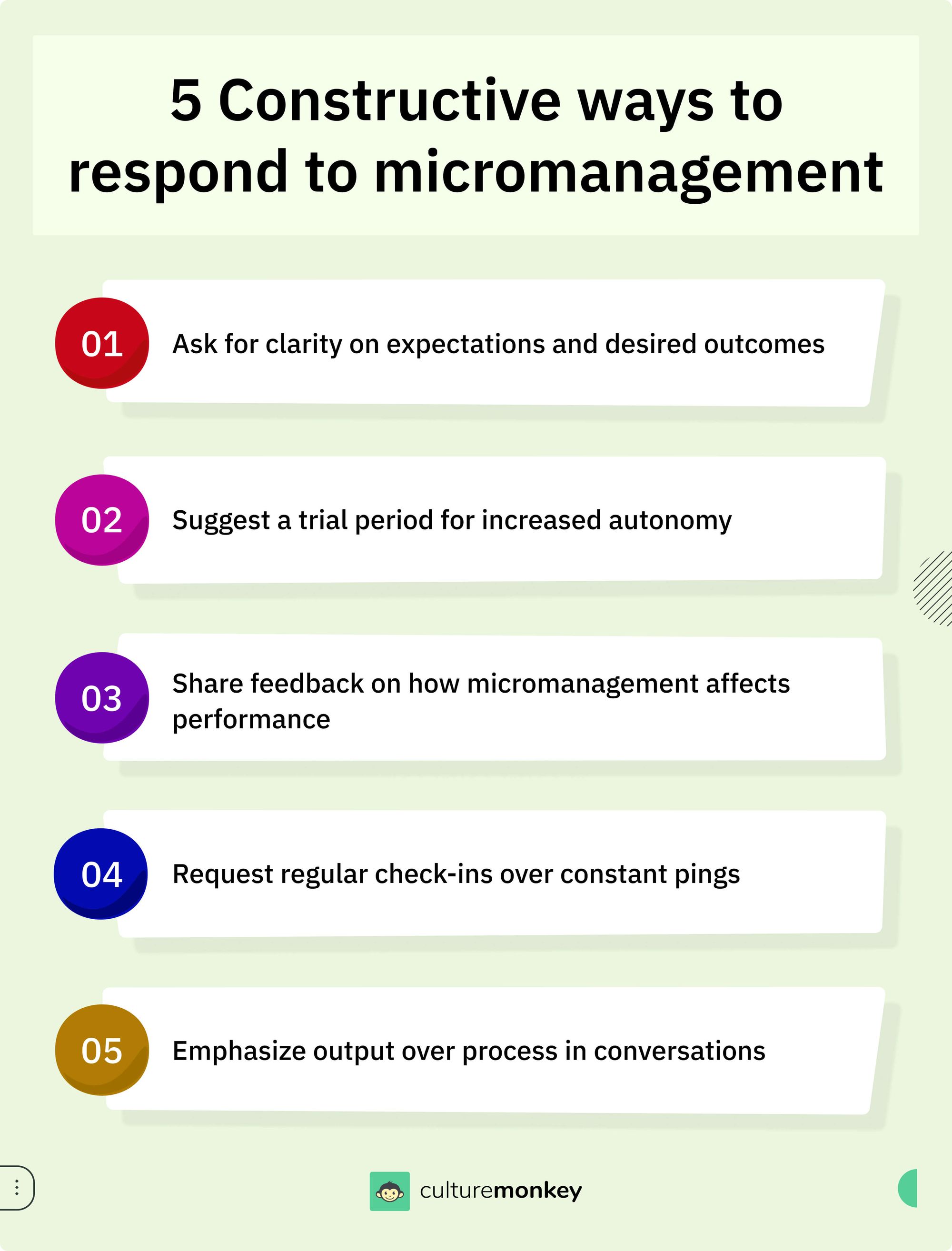Micromanaging examples: Top 60+ signs to watch out for in 2025

Ever tried teaching a toddler how to tie their shoes? At first, they fumble with the laces, creating a mess of loops and knots. You watch, resisting the urge to jump in. But after what feels like an eternity, you cave. “Here, let me do it.” You swiftly tie the perfect bow, saving time and frustration.
But what happens the next day? The toddler stares at their untied shoes, waiting for you. They never learn—because you never let them.
Micromanagement works the same way. Leaders, with the best intentions, step in too often, stifling confidence and autonomy. The result? Teams that hesitate, second-guess, and ultimately rely too much on approval.
In this blog, we’ll dive into real micromanaging examples and the top signs to watch out for in 2025—so you can spot the behavior before it stunts growth.
TL;DR
Blog Highlights


What is micromanaging at work?

TL;DR
Micromanaging at work means excessive control and constant oversight, leaving little room for autonomy or creativity. Classic what is micromanaging examples include second-guessing, hovering, and over-criticism.
This toxic style stifles innovation, lowers morale, and hurts productivity. Recognizing micro managing definition and its effects is crucial to fostering trust and empowering employees to succeed.
Ever watched someone try to build a puzzle—only to have someone else keep rearranging their pieces? That’s micromanaging in a nutshell. It’s a management style marked by excessive control, constant check-ins, and little room for independent thinking. From demanding daily updates to reworking small decisions, micromanagement takes many forms.
These include hovering over tasks, second-guessing choices, and being overly critical—classic what is micromanaging examples. The micro managing definition is simple: it’s control gone overboard.
And here’s why micromanaging is toxic—it crushes creativity, deflates morale, and stunts productivity. Instead of fostering trust, it breeds frustration and burnout. Understanding the forms of micromanagement is key to breaking the cycle—and building a team that thrives, not just survives.



Micromanaging erodes people's confidence, making them overly dependent on their leaders.
Author
Types of micromanagement
Micromanagement can take different forms, each affecting workplace dynamics and employee productivity in various ways. Understanding these types helps in identifying and addressing signs of micromanagement before they create a toxic work environment.
TL;DR
Micromanagement takes many forms, including task-based, decision-making, communication, time-based, and innovation-stifling behaviors. These approaches overly control how employees work, decide, communicate, and manage time, while discouraging creativity.
Recognizing these examples of micromanagement early helps prevent a toxic environment, restore trust, and empower employees to work independently and contribute meaningfully to organizational success.
- Task-based micromanagement: This occurs when a manager excessively controls how tasks are performed, providing unnecessary details and monitoring every step. Examples of micromanagement include constant revision requests, over-explaining simple assignments, and refusing to delegate.
- Decision-making micromanagement: Some managers insist on approving every decision, no matter how minor. This prevents employees from making choices independently and slows progress. A classic example of micromanagement is when even routine tasks require managerial approval, hindering efficiency.
- Communication micromanagement: A micromanaging boss example is one who controls how, when, and where employees communicate. They may dictate specific email formats, insist on being cc’d in every message, or restrict informal discussions, leading to a lack of trust.
- Time-based micromanagement: Managers obsessed with tracking employee schedules down to the minute create an atmosphere of stress. Micro managing in this way includes excessive time-tracking tools and constant status updates, reducing productivity.
- Innovation-stifling micromanagement: Employees feel discouraged from thinking creatively when managers enforce rigid structures. This type of micro management makes workers hesitant to suggest new ideas for fear of rejection.
Why do managers micromanage?

Managers may resort to micromanagement for various reasons, which can be both conscious and subconscious. Understanding these motives can shed light on why micromanagement occurs:
- Lack of trust: Managers may micromanage when they lack trust in their team's capabilities. This distrust can result from past experiences, insecurity, or concerns about subpar performance.
- Perfectionism: Perfectionist tendencies can drive managers to micromanage as they aim for flawless outcomes. They may believe that their way is the only path to perfection.
- Insecurity: Insecure managers may fear that their team's success could overshadow their own. Micromanaging can be a way to maintain control and ensure they are seen as indispensable.
- Desire for control: Some managers have a strong need for control and may micromanage to maintain a tight grip on operations. They find comfort in overseeing every detail.
- Pressure from above: Upper management or external stakeholders may exert pressure on managers to deliver specific results. This pressure can trickle down and lead to micromanagement as managers try to meet expectations.
- Lack of training: Managers who haven't received proper leadership training might resort to micromanagement because they don't know how to effectively delegate and guide their teams.
- Fear of failure: Fear of failure, particularly when facing tight deadlines or critical projects, can drive managers to micromanage to ensure success and avoid negative consequences.
- High-stakes projects: In situations where the stakes are exceptionally high, such as mergers or major product launches, managers might micromanage to minimize risks.
- Communication gaps: Managers who struggle with effective communication may resort to micromanagement as they find it challenging to convey their expectations clearly.
- Past negative experiences: A manager's past negative experiences, such as team members not meeting deadlines, can lead to a lack of trust and micromanagement as a defensive mechanism.
- Overwhelming workload: Managers with an excessive workload may resort to micromanaging as a way to stay on top of tasks and ensure everything is progressing according to their standards.
- Controlled work environment: Some managers prefer a controlled work environment and may micromanage to maintain order, especially in dynamic or uncertain situations.
- Personal performance metrics: Managers driven by personal performance metrics or key performance indicators (KPIs) may micromanage to meet specific targets, sometimes at the expense of team autonomy.
- Lack of feedback mechanisms: When managers lack effective feedback mechanisms, they may resort to micromanaging to compensate for the absence of regular performance evaluations.
- Team composition challenges: Managers facing challenges with team composition, such as a mix of experienced and inexperienced members, may micromanage to bridge skill gaps and ensure a cohesive workflow.
- Unclear organizational goals: Managers operating in environments with ambiguous or constantly shifting organizational goals may micromanage to ensure alignment with overarching objectives, even at the expense of autonomy and creativity.
- Lack of role clarity: In situations where roles and responsibilities within the team are poorly defined or constantly changing, managers may feel compelled to micromanage to prevent confusion and maintain operational efficiency.
What are the 60+ signs of micromanaging?
Identifying micromanagement within the workplace can help mitigate its adverse effects on employees and productivity. Here are over 50 common signs of micromanaging:
TL;DR
Micromanagement shows through overcontrol, lack of trust, rigid processes, constant monitoring, and dismissing employee input. It creates stress, stifles creativity, delays decisions, and undermines morale.
Recognizing signs like excessive oversight, revision demands, nitpicking, and blocking autonomy helps organizations address this behavior early, fostering trust, engagement, and a healthier, more productive workplace environment.
- Constant oversight: A micromanager closely monitors every task and demands frequent updates, even for routine assignments.
- Lack of delegation: They struggle to delegate responsibilities, preferring to retain control over all decisions and tasks.
- Detailed instructions: Micromanagers provide excessively detailed instructions, leaving little room for individual initiative or creativity.
- Frequent check-ins: They require frequent check-in meetings or status reports, often more than necessary.
- Involvement in minor decisions: Micromanagers involve themselves in even trivial decisions that should be handled by employees.
- Revision requests: They habitually request revisions on completed work, often without clear reasons or substantial improvements.
- Reluctance to trust: Micromanagers show a lack of trust in their team's abilities, leading to constant skepticism and questioning.
- Fear of mistakes: They are overly focused on avoiding mistakes, leading to risk aversion and stifling innovation.
- Personal involvement: Micromanagers tend to take over tasks that fall within their employees' roles, causing frustration and undermining confidence.
- Increased stress: Team members under a micromanager often experience heightened stress, decreased job satisfaction, and decreased morale.
- Resistance to autonomy: Micromanagers resist granting autonomy to their team members, insisting on being overly involved in every decision, regardless of its significance.
- Excessive email monitoring: They engage in constant monitoring of team members' email correspondence, seeking to stay informed about every communication.
- Micro-managing deadlines: Micromanagers not only set deadlines but also closely monitor the daily progress towards these deadlines, leaving little room for flexibility or unforeseen challenges.
- Overemphasis on processes: They place an excessive emphasis on following rigid processes, often overlooking the potential benefits of adaptability and creativity.
- Obsessive focus on details: Micromanagers may become fixated on minor details, losing sight of the bigger picture and hindering overall progress.
- Intolerance for independent opinions: They display intolerance towards independent opinions or suggestions that deviate from their own, discouraging a diverse range of ideas within the team.
- Constant monitoring tools: Micromanagers may implement constant monitoring tools or software to track employees' activities, further diminishing trust and autonomy.
- Micromanaging communication channels: Micromanagers dictate the specific channels employees must use to communicate, limiting their ability to choose the most efficient or appropriate method for each situation.
- Overbearing involvement in training: Micromanagers insist on overseeing every aspect of employee training, from curriculum development to delivery, stifling trainers' expertise and hindering the learning process.
- Nitpicking insignificant details: Micromanagers excessively scrutinize trivial aspects of work, such as font size or color choices in a presentation, causing unnecessary delays and frustration among team members.
- Ignoring boundaries: A micromanager often disregards personal and professional boundaries, expecting employees to be available beyond working hours or interfering in tasks that should be left to the team.
- Communication gaps: Despite constant oversight, micromanagers may fail to communicate effectively, leading to confusion, misalignment, and frustration among team members.
- Fear of conflict: Many micromanagers avoid difficult conversations or constructive feedback, preferring excessive control to prevent disagreements rather than addressing issues directly.
- High turnover: Employees working under micromanagement often feel frustrated and unvalued, leading to disengagement and increased resignation rates.
- Inexperience in management: Some micromanagers lack leadership experience and resort to excessive control because they are unsure how to lead effectively.
- Insecurity: Personal insecurities about their role or performance may drive a micromanager to seek constant validation, making them over-involved in every aspect of their team’s work.
- Lack of flexibility: Micromanagers insist on rigid processes and struggle to adapt to new ideas or changing circumstances, even when better solutions exist.
- Over-reliance on approval: Employees must seek approval for even minor decisions, slowing down productivity and preventing independent problem-solving.
- Creates a fear-driven environment: Employees hesitate to take initiative, fearing mistakes will be met with criticism rather than constructive feedback.
- Difficulty recognizing success: Instead of celebrating achievements, micromanagers focus on what could have been done better, making employees feel their work is never enough.
- Lack of focus on employee development: Rather than mentoring and fostering professional growth, micromanagers prioritize control, preventing skill-building and autonomy.
- Micromanaging remote teams: Even in remote work settings, micromanagers demand excessive check-ins, track work hours rigidly, and insist on constant availability, reducing trust and efficiency.
- Over-documenting tasks: Micromanagers require employees to create extensive documentation for even the smallest tasks, wasting time and signaling a lack of trust.
- Rewriting completed work: Rather than giving feedback, they often rewrite deliverables entirely—even when no real improvement is made.
- Disregarding team input: Even when seeking feedback, micromanagers often ignore it, sticking to their original idea regardless of the team’s insights.
- Imposing personal preferences: They expect work to be done their way—even when it's a matter of style, not substance.
- Blocking decision-making authority: Employees aren’t allowed to make even low-stakes decisions without sign-off, leading to bottlenecks.
- Shadowing employee tasks: Some micromanagers literally stand behind team members or hover on virtual calls, watching them work.
- Mandating rigid schedules: Even when flexibility is possible, micromanagers enforce strict start and stop times that don’t account for personal productivity rhythms.
- Requiring approval for communication: Emails, presentations, or client messages must be pre-approved, delaying communication flow.
- Monitoring breaks: They track coffee breaks, lunch durations, or quick pauses—implying employees can’t manage their own time.
- Discouraging delegation within the team: Even team leads aren’t allowed to delegate; the micromanager must approve every task assignment.
- Creating redundant approval chains: They add layers of unnecessary approvals just to stay in control, killing momentum.
- Using guilt as a control tactic: Employees are made to feel guilty for working independently or not involving the manager in every detail.
- Jumping in during presentations: Micromanagers interrupt team members during client calls or presentations, undermining their authority.
- Treating small errors like crises: Minor mistakes are met with overblown reactions, creating a culture of fear.
- Punishing initiative: Taking initiative without permission is met with criticism, even if the result is positive.
- Obsessing over time tracking tools: Tools like Toggl or Clockify are used less for productivity and more for employee surveillance.
- Changing direction frequently: Constant micromanaging often leads to frequent shifts in strategy, confusing the team.
- Taking credit for team achievements: Micromanagers often frame wins as a result of their control, not the team's effort.
- Micromanaging collaboration tools: They monitor every Slack message, comment thread, or shared doc update.
- Downplaying employee expertise: Even when employees are subject matter experts, micromanagers override their choices, sending the message: “I know better.”
- Overloading employees with unnecessary tasks: Assigning excessive busywork just to keep control over employees’ time and focus.
- Second-guessing every decision: Routinely questioning and revisiting employee decisions, even after approval, causing confusion and delays.
- Ignoring employee suggestions: Actively soliciting ideas but dismissing them outright, discouraging future contributions.
- Overly prescriptive workflows: Dictating exactly how every step must be done, leaving no room for individual problem-solving.
- Dominating team meetings: Talking over employees or dominating discussions, leaving little space for others to speak.
- Constantly revising priorities: Regularly shifting focus without explanation, making it impossible for employees to complete tasks effectively.
- Micromanaging personal workspaces: Commenting on how employees arrange their desks, screens, or home office setups.
- Obsessing over appearance: Critiquing minor aspects of how employees dress or present themselves, even when appropriate.
- Monitoring tone in emails: Policing how employees word emails or messages, even when the content is clear and professional.
- Reluctance to share information: Hoarding knowledge and only releasing details at the last minute to retain control.
- Fostering unhealthy competition: Pitting employees against each other to maintain dominance and control over the team dynamic.
Is micromanaging a form of narcissism?
While micromanaging and narcissism share some similarities, they are not the same. According to the micromanage definition, it involves excessive control and attention to detail, but this doesn’t always indicate narcissistic behavior.
What is micromanaging really about? Often, it stems from insecurity, fear of failure, or a lack of trust in the team rather than an inflated sense of self-importance. The micromanaging meaning differs from narcissism, which is characterized by a need for admiration and a lack of empathy.
While micro managing can feel controlling, it is often driven by anxiety over performance and perfectionism. Many examples of micromanagement arise from leaders struggling to delegate, not necessarily from a narcissistic mindset.
Understanding whether micro management is a leadership flaw or a deeper issue helps in addressing it effectively. Differentiating management styles from personality traits ensures that interventions focus on correcting behavior rather than mislabeling individuals.
Micromanaging vs. supporting: How to tell the difference
Leaders often blur the line between supporting and controlling. This table highlights key differences, with subtle micromanagement examples to illustrate when support crosses into harm.
| Aspect | Supporting | Micromanaging |
|---|---|---|
| Trust | Shows confidence in employees’ abilities and decisions. | Constant oversight signals distrust. Examples of micromanagement include second-guessing. |
| Autonomy | Encourages independent thinking and decision-making. | Strips autonomy; micromanaging meaning becomes dictating every choice. |
| Feedback | Gives constructive, growth-oriented feedback. | Focuses on minor flaws; examples of micromanaging show nitpicking without praise. |
| Process vs. outcome | Respects different work styles as long as goals are met. | Fixates on every step; micro management examples include rigid process control. |
| Emotional impact | Builds morale and motivation through support. | Creates stress and insecurity; raises the question: Is micromanagement bullying? |
| Long-term growth | Develops skills for future success. | Hinders development by keeping control; classic examples of micromanagement. |
What is toxic micromanagement?
Toxic micromanagement is an extreme micromanage meaning that goes beyond oversight, creating a suffocating work environment. Unlike constructive leadership, it stifles autonomy, creativity, and job satisfaction.
What is micromanaging? It’s more than just control—it’s an intrusive need to oversee every detail, leaving employees feeling undervalued and disempowered. What does micromanaging look like? It involves relentless scrutiny, unrealistic expectations, and a constant demand for validation.
Signs of micromanagement include excessive approvals, fear-driven environments, and a lack of trust in employees’ capabilities. These forms of micromanagement lead to stress, burnout, and high turnover rates, showing why micromanaging is toxic for any workplace.
Understanding what causes micromanagement—whether insecurity, fear of failure, or perfectionism—helps in tackling the issue. If you're struggling with a controlling boss, learning how to manage a micromanager is key. Recognizing the traits of a micromanager is the first step in fostering a healthier, more trusting work culture.
Is micromanaging bullying?

Micromanagement is not inherently bullying, as it usually stems from control issues rather than intent to harm. However, when it involves intimidation, humiliation, or exclusion, it can cross the line into workplace bullying.
| Aspect | Micromanagement | Workplace Bullying |
|---|---|---|
| Definition | Excessive oversight and control over employees' tasks and decisions. | Intentional mistreatment aimed at belittling or harming an employee. |
| Core behavior | Focused on controlling work processes, monitoring tasks, and requiring frequent updates. | Includes aggression, humiliation, exclusion, or verbal abuse. |
| Intent | Typically stems from insecurity, perfectionism, or lack of trust in employees. | Deliberate actions meant to demean, intimidate, or exert power over an employee. |
| Impact on employees | Creates stress, reduces autonomy, and stifles creativity. | Leads to emotional distress, fear, and possible long-term psychological harm. |
| How it manifests | Frequent check-ins, excessive approvals, nitpicking details, and lack of delegation. | Repeated personal attacks, public humiliation, undermining work, and spreading rumors. |
| Workplace consequences | Low morale, burnout, frustration, and decreased productivity. | High turnover, toxic work environment, and significant emotional damage. |
| How to address it | Coaching the manager on leadership skills, promoting autonomy, and fostering trust. | Implementing strict anti-bullying policies, HR interventions, and legal actions if necessary. |
Micro manage meaning vs macromanage

| Aspect | Micro-management | Macro-management |
|---|---|---|
| Definition | Closely overseeing and controlling every aspect of tasks or projects. | Setting broad goals while allowing employees autonomy in execution. |
| Control level | Frequent monitoring, intervention, and excessive focus on details. | Strategic oversight with minimal interference in daily tasks. |
| Trust in employees | Low trust, with a need for complete control over outcomes. | High trust, empowering employees to take ownership of their work. |
| Employee autonomy | Limited autonomy, leaving employees feeling disempowered. | Greater autonomy, fostering accountability and confidence. |
| Work environment | Creates stress and increases the risk of burnout. | Encourages a positive, stress-free environment with room for growth. |
The psychological effects of micromanagement
Micromanagement is more than just excessive oversight—it chips away at confidence, stifles creativity, and creates a toxic work environment that leaves employees drained and disengaged.
TL;DR
Micromanagement damages mental health by eroding confidence, fueling anxiety, and stifling creativity. It strips autonomy, drains motivation, and leads to burnout, frustration, and disengagement.
Persistent examples of micromanagement create toxic environments, increasing turnover as employees seek workplaces where they feel trusted, valued, and empowered to contribute meaningfully without constant oversight or fear of criticism.
- Erosion of confidence and self-esteem: A micromanaging boss constantly questioning decisions makes employees doubt their own abilities, leading to stress and self-doubt.
- Increased anxiety and fear: Is micromanaging bullying? It can feel that way when every move is scrutinized, making employees hesitant to take initiative or voice opinions.
- Stifled creativity and innovation: When leaders enforce rigid processes, employees focus on avoiding mistakes rather than exploring new ideas—one of the classic examples of micromanagement.
- Loss of autonomy and motivation: The constant need for approval turns work into a task-driven routine rather than a role with purpose—an example of micromanagement that leads to disengagement.
- Burnout and frustration: Persistent oversight drains energy and enthusiasm, one of the clear signs of micromanagement that pushes employees toward exhaustion.
- Higher turnover rates: Feeling undervalued and over-controlled, employees often leave in search of healthier work cultures, proving that examples of micromanaging lead to costly attrition.
Impact of micromanagement on employees
Micromanagement creates a restrictive work environment that stifles creativity, lowers morale, and reduces overall productivity.
- Erosion of confidence: Constant oversight and lack of trust, common in examples of micromanaging, make employees second-guess their abilities and decisions.
- Increased stress and anxiety: The pressure of micro managing every detail leads to frustration, burnout, and emotional exhaustion.
- Reduced autonomy and motivation: A workplace dominated by micro management leaves employees feeling powerless, making them disengaged and unmotivated.
- Lack of innovation: When a micromanaging boss example insists on rigid processes, employees hesitate to share ideas, limiting creativity.
- Fear-driven culture: Employees working under signs of micromanagement may wonder, is micromanaging bullying?—as it often creates an intimidating atmosphere.
- High turnover rates: Persistent micromanagement examples contribute to dissatisfaction, pushing employees to seek better work environments.
15 Adverse effects of micromanagement in the workplace

Micromanagement can have numerous adverse effects on both employees and the workplace environment. Here are 15 common negative consequences of micromanaging:
TL;DR
Micromanagement harms employees and workplaces by lowering morale, motivation, and trust while increasing stress, burnout, and turnover. It stifles creativity, learning, communication, and innovation, damaging team dynamics and fostering a negative culture.
Over time, it erodes job satisfaction and tarnishes the company’s reputation, making it harder to attract and retain top talent.
- Decreased morale: Employees subjected to constant oversight and scrutiny often experience lower morale, leading to decreased job satisfaction.
- Reduced motivation: Micromanagement can demotivate employees as they feel their efforts are not trusted or appreciated.
- Impaired creativity: The stifling environment created by micromanagers can inhibit creative thinking and innovation.
- Higher stress levels: Constant pressure and the fear of making mistakes can increase employee stress and anxiety.
- Burnout: Micromanagement can contribute to burnout as employees struggle to meet unrealistic expectations.
- Reduced productivity: Ironically, micromanagement can lead to decreased productivity as employees become preoccupied with satisfying the manager's demands.
- High turnover: Frustrated employees may seek alternative job opportunities, leading to higher turnover rates.
- Decreased trust: Trust between employees and their manager erodes when micromanagement is prevalent.
- Inhibited learning: Employees may become overly reliant on the manager for guidance, hindering their professional growth and learning.
- Impaired team dynamics: The team's cohesiveness can suffer as employees become frustrated with the micromanager's interference.
- Communication breakdown: Micromanagement often leads to a breakdown in communication as employees may hesitate to share ideas or concerns, fearing unnecessary scrutiny or criticism.
- Innovation stagnation: The constant need for approval and adherence to rigid instructions can stifle the culture of innovation within a team, hindering the development of new ideas and approaches.
- Negative workplace culture: Micromanagement fosters a negative workplace culture where employees feel constrained and disempowered, leading to a lack of collaboration and camaraderie.
- Erosion of job satisfaction: The cumulative effects of micromanagement can erode overall job satisfaction, making it challenging for employees to find fulfillment in their roles.
- Impact on company reputation: A workplace known for micromanagement may struggle to attract top talent, and its reputation in the industry may suffer, affecting the company's long-term success.
How to deal with micromanagement?

Dealing with micromanagement can be challenging, but it's possible to navigate this situation effectively. Here are eight strategies for addressing micromanagement in the workplace:
- Initiate open communication: Approach your manager and express your desire for more autonomy and trust in your abilities. Use "I" statements to convey your feelings and concerns without sounding accusatory.
- Understand the root cause: Try to understand why your manager may be micromanaging. Are there external pressures, or have there been past issues with the team's performance? This understanding can help you tailor your approach to address their specific concerns.
- Demonstrate competence: Consistently deliver high-quality work to build trust and confidence in your abilities. Share your achievements and progress with your manager proactively.
- Seek clarification: When given vague instructions, ask for clarification to ensure you understand expectations clearly. This can reduce the need for excessive oversight.
- Request feedback: Encourage regular feedback discussions with your manager to receive constructive input on your performance. This can help build trust and reduce the need for micromanagement.
- Propose a trial period: Suggest a trial period during which you can work with more autonomy and report back on your progress. This approach allows your manager to gradually let go of control.
- Offer solutions: If you identify specific challenges that contribute to micromanagement, propose solutions to address them. This proactive approach can demonstrate your commitment to improvement.
- Seek support from HR or higher management: If your efforts to address micromanagement within your team prove unsuccessful, consider discussing the issue with HR or higher management. Present your case professionally, focusing on the impact on productivity and morale.

Reset the way you lead
– one day at a time
Trade control for trust. Shift from micromanaging to mentoring. Because empowered teams don’t just happen—they’re built by leaders who choose growth over grip.
How can managers avoid micromanaging their employees?
Managers can adopt various strategies to avoid micromanaging their employees while still ensuring tasks are completed effectively. Here are nine creative and unique approaches:
- Establish clear expectations and objectives: Begin by setting clear expectations and objectives for each project or task. Ensure employees understand the desired outcomes, timelines, and any critical milestones. Instead of specifying every detail of how to complete a task, focus on the "what" and "why" rather than the "how."
- Promote a culture of empowerment: Create a culture where employees are encouraged to take ownership of their work. Emphasize the importance of autonomy and trust in decision-making. Provide opportunities for employees to contribute their ideas and suggestions, fostering a sense of ownership and responsibility.
- Delegate with purpose: Delegate tasks based on employees' strengths and interests. Allow them to take on responsibilities that align with their skills and career goals. Offer guidance and support when needed, but refrain from micromanaging the entire process. Encourage employees to find their purpose at work.
- Encourage two-way communication: Promote open and transparent communication channels. Create an environment where employees feel comfortable discussing challenges, seeking feedback, and sharing progress updates. Encourage regular one-on-one meetings to address concerns, provide guidance, and offer constructive feedback.
- Provide training and resources: Invest in training and development opportunities for your team to enhance their skills and knowledge. Equip employees with the tools and resources they need to excel in their roles, reducing the need for constant supervision.
- Encourage a healthy work-life balance: Recognize the importance of work-life balance and avoid expecting employees to be constantly available. Promote a supportive environment that values the well-being of employees, reducing the likelihood of burnout and stress associated with micromanagement.
- Empower through mentorship: Establish mentorship programs or encourage informal mentor-mentee relationships within the team. This fosters a supportive environment where less-experienced employees can seek guidance without feeling micromanaged.
- Acknowledge and celebrate achievements: Create a culture of recognition by acknowledging and celebrating individual and team achievements. Regularly highlight accomplishments, both big and small, to show that their efforts are valued and that you trust them to excel in their roles.
- Flexibility in approach: Recognize that different tasks and individuals may require varying levels of oversight. Adapt your management approach based on the complexity of the task, the experience level of the employee, and the overall team dynamics. Flexibility allows you to provide the right level of guidance without stifling creativity or hindering productivity.
11 Micromanaging examples at work

Micromanagement at work can manifest in various ways, and recognizing these examples is crucial to addressing the issue effectively. Here are 11 common micromanaging examples in the workplace:
TL;DR
Micromanagement at work shows up through excessive oversight, rigid instructions, and constant monitoring of emails, time, and decisions. It undermines trust by second-guessing, revising work unnecessarily, and limiting autonomy.
Invasive behaviors, like hovering or invading personal space, further erode confidence, creativity, and morale, highlighting the damaging effects of these controlling workplace practices.
- Excessive oversight: When a manager constantly monitors an employes work progress, requesting frequent updates and detailed reports.
- Detailed task instructions: Providing overly specific instructions for assigning tasks, leaving little room for employee discretion or creativity.
- Constant email monitoring: Checking and responding to an employee's emails without their consent, even if the content is not confidential.
- Unwarranted supervision: A manager physically standing over an employee's shoulder while they work, often without a valid reason.
- Involvement in minor decisions: Making decisions on behalf of employees for matters that fall within their job description and should be within their control.
- Revision requests: Consistently request revisions on completed work, sometimes without providing clear feedback or rationale.
- Second-guessing: Continually questioning an employee's decisions or actions, undermining their confidence.
- Time management scrutiny: Excessively monitoring an employee's time, down to the minute, rather than focusing on results and outcomes.
- Task duplication: Duplicating tasks that an employee has already completed, indicating a lack of trust in their ability.
- Lack of autonomy: Providing minimal autonomy and forcing employees to seek approval for even minor decisions.
- Personal space invasion: Encroaching an employee's personal space, such as their desk or workspace, without a valid reason.

Micromanaging examples in hybrid and remote teams
Remote and hybrid work has amplified the risks of micromanaging, as some leaders overcompensate for the lack of physical oversight. Here are six micromanaging examples that highlight what is micromanagement and its impact on virtual teams.
- Requiring constant status updates: An example of micromanagement in remote settings is asking employees for hourly updates or real-time reports, showing a lack of trust and misunderstanding of results-focused work.
- Overusing monitoring tools: Leaders who install invasive tracking software misunderstand micro management meaning, turning flexibility into surveillance. This raises the question: Is micro managing bullying when it invades personal space?
- Dictating work hours rigidly: Ignoring time zone differences or personal productivity rhythms reflects a poor grasp of micro management definition and disregards the autonomy remote work offers.
- Taking over digital collaboration spaces: Managers who hijack Slack threads, edit live documents excessively, and dominate calls illustrate what does micromanaging look like in a hybrid team.
- Mandating unnecessary meetings: Scheduling daily or even twice-daily check-ins despite clear progress misunderstands micromanage meaning as “always be involved,” rather than enabling independence.
- Policing communication tone and style: Correcting every email or chat message for tone or format shows a skewed view of what is micromanagement, stifling employees’ authentic voices.
5 Micromanaging boss examples

A micromanaging boss can be a challenging presence in the workplace, impacting employee morale, productivity, and job satisfaction. Here are five examples of micromanaging boss behaviors:
- Constant supervision: Micromanaging bosses often hover over their employees, closely monitoring every action and decision. They may stand near employees' desks or frequently check in on their progress, leading to a stifling work environment where employees feel they lack autonomy.
- Detailed task instructions: Micromanagers provide excessively detailed instructions for tasks, leaving little room for employee creativity or problem-solving. They may dictate precisely how each step should be carried out, leading to frustration and a lack of ownership among employees.
- Frequent check-ins: Micromanaging bosses demand frequent check-in meetings or updates, often more than necessary. These interruptions disrupt employees' workflow and can hinder their ability to focus on their tasks.
- Involvement in minor decisions: Micromanagers insert themselves into even minor decisions that should be handled by employees. This can lead to a slow decision-making process and employees feeling undervalued.
- Revision requests: Micromanagers consistently request revisions on completed work, often without providing clear feedback or substantial improvements. Employees may find themselves making multiple revisions to satisfy their boss's exacting standards.
To address a micromanaging boss, employees can consider open and respectful communication. Initiating a conversation about trust, autonomy, and the desire for more independence in tasks can help.
Benefits of a manager effectiveness survey in tackling micromanagement
Implementing a manager effectiveness survey through an employee engagement survey provider can offer several key advantages in improving leadership and workplace dynamics.
TL;DR
A manager effectiveness survey helps tackle micromanagement by revealing problematic behaviors through heatmaps, customizable templates, and sentiment analysis. It uncovers examples of micromanaging, tracks employee perceptions of what is micromanaging, and provides actionable plans.
These insights enable managers to reduce excessive control, foster trust, and improve leadership effectiveness, enhancing workplace engagement and autonomy.
- Heatmap visualization: A visual representation of survey data helps identify managerial strengths and weaknesses, making it easier to pinpoint examples of micromanagement and recognize when micro-managing is affecting productivity. This tool can highlight signs of micromanagement, such as excessive control or lack of delegation.
- Manager effectiveness survey templates: Customizable surveys allow organizations to ask direct questions about leadership styles, helping uncover what is micromanaging and whether employees feel trapped under micromanaging boss examples. These surveys provide insights into whether micromanagement is fostering disengagement.
- Built-in Likert scale: Standardized response options enable employees to rate leadership effectiveness, making it easier to track behaviors aligned with micro management. Responses often reflect concerns about micromanaging meaning, helping organizations address problematic management styles.
- Sentiment analysis tools: Analyzing open-ended responses helps identify underlying workplace concerns, such as whether employees feel that is micromanaging bullying or if they experience constant oversight that mirrors examples of micromanaging. This tool reveals subtle patterns in employee sentiment linked to micromanagement examples.
- Action planning features: Beyond collecting data, survey tools provide structured plans for improvement, helping managers move away from example of micromanagement tendencies. These features address behaviors commonly associated with micromanaging while encouraging autonomy and trust.
Conclusion
Micromanagement at work is a management style characterized by excessive control, close supervision, and a focus on minute details. It can manifest in various ways, such as constant oversight, detailed task instructions, and a lack of autonomy for employees.
Recognizing the signs of micromanagement is crucial, as it can have detrimental effects on morale, creativity, and productivity. A manager effectiveness survey can help identify these issues by gathering honest feedback from employees about their leadership experience.
Platforms like CultureMonkey provide valuable tools to assess management styles, offering insights into how managers can improve their leadership approach.
By leveraging a manager effectiveness survey through CultureMonkey, organizations can pinpoint areas where managers may be over-controlling and take proactive steps to create a more collaborative and empowering work environment.
Summary
Giving feedback to managers is key to fostering a healthy, growth-driven culture. This article clearly outlines what micromanagement looks like through 50+ practical examples. It helps teams identify common control-based behaviors, offering insights into how they impact trust and productivity.
By normalizing discussions around micromanaging, the article encourages open communication, stronger leadership, and a shift toward more empowering, autonomy-focused management styles across organizations.
FAQs
1. Is micromanaging a hostile work environment?
While micromanaging isn't inherently a hostile work environment, it can contribute significantly to one. Constant scrutiny and control can create stress, eroding trust and fostering a negative atmosphere. Employees feeling disempowered and undervalued due to micromanagement often experience decreased morale and productivity, which can ultimately contribute to the development of a hostile work environment.
2. Why do people micromanage?
The micromanaging definition stems from traits of a micromanager, like perfectionism, insecurity, and control. Being micromanaged at work can feel draining, and some ask if micromanagement is harassment. If your manager is micromanaging, set boundaries and communicate clearly. Learning how to manage a micromanager helps protect morale and foster healthier collaboration.
3. How does micromanaging differ from providing necessary guidance or supervision?
Micromanaging involves excessive control and interference in tasks, often driven by a lack of trust and desire for complete control. Conversely, providing necessary guidance or supervision involves offering support, clarifying expectations, and empowering employees to make decisions autonomously within a framework of trust and respect. Effective supervision promotes employee development and fosters a positive work environment.
4. What constitutes a hostile work environment?
A hostile work environment encompasses behaviors or conditions that create an intimidating, offensive, or abusive atmosphere for employees. This can include harassment, discrimination, bullying, and pervasive negativity that interferes with employees' ability to perform their job duties effectively. A hostile environment undermines morale, contributes to stress, and may lead to legal implications for the organization if left unaddressed.
5. Are there specific industries or types of work environments where micromanaging tends to be more prevalent?
Micromanagement tendencies can be found across various industries and work environments. However, they may be more prevalent in highly regulated sectors like finance, healthcare, and government, where precise control and risk management are paramount. Additionally, fast-paced industries with high-pressure environments may exhibit higher levels of micromanagement as managers seek to maintain control and ensure compliance with strict regulations.
6. How to hold employees accountable without micromanaging
Focus on clear goals and outcomes instead of controlling every step. Avoid micromanagement examples like constant check-ins and nitpicking. Foster trust by letting employees own their work while providing guidance only when needed. This prevents slipping into examples of micromanagement that harm autonomy and morale.
7. Can you give feedback to a micromanaging manager?
Yes, respectfully share how examples of micromanagement affect your work. Use specific micromanagement examples, such as unnecessary revisions or constant oversight, to illustrate your point. Framing feedback as a way to improve trust and productivity can open dialogue without making them defensive or asking “is micromanagement bullying?” outright.
8. What’s the difference between micromanaging and good leadership?
Good leadership empowers, while micromanagement controls. Leaders guide with trust, avoiding examples of micromanagement like dictating every task or ignoring team input. Recognizing micromanagement examples—such as second-guessing decisions or excessive monitoring—helps distinguish supportive leadership from behavior that makes employees wonder is micromanagement bullying?.
9. How can HR reduce micromanagement across departments?
HR can educate managers about the impact of examples of micromanagement, provide training on trust-based leadership, and monitor employee feedback. Addressing micromanagement examples early fosters a healthier culture. Openly discussing if employees feel is micromanagement bullying helps HR create safer, more productive work environments.
10. Why do managers micromanage even when they trust their team?
Some managers fall into micromanagement examples out of habit, fear of failure, or pressure from above. Even with trust, they may believe control ensures results. Recognizing examples of micromanagement and asking “is micromanagement bullying?” can help managers reflect and shift toward empowering their teams effectively.
11. What are constructive alternatives to micromanaging?
Instead of control, try clear expectations, open dialogue, and trust. These combat toxic micromanagement and support team growth. Leaders should replace micromanaging examples with coaching and mentoring. Offering feedback without controlling every move avoids micro management definition traps and helps dismantle the culture built by signs of a micromanaging boss and rigid control.
12. How can leaders shift from micromanaging to empowering their teams?
Start by recognizing what micromanaging is and its impacts. Shift from policing to trusting—delegate meaningfully, celebrate wins, and allow room for mistakes. Rather than displaying examples of micromanagement, adopt mentorship. If you’re wondering, is micromanaging bullying? It can feel that way. Let go of the a micro manager mentality—and grow into a leader who lifts.




